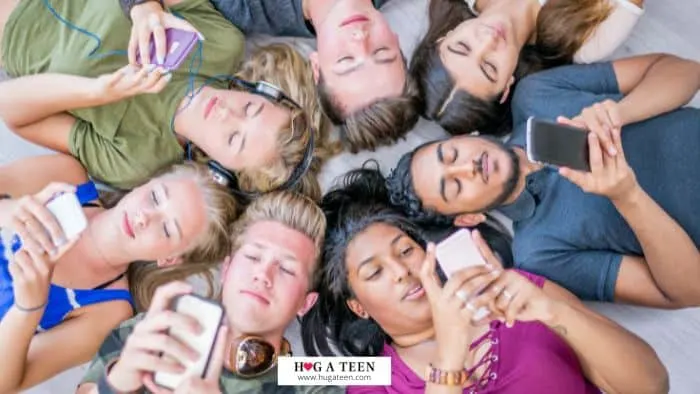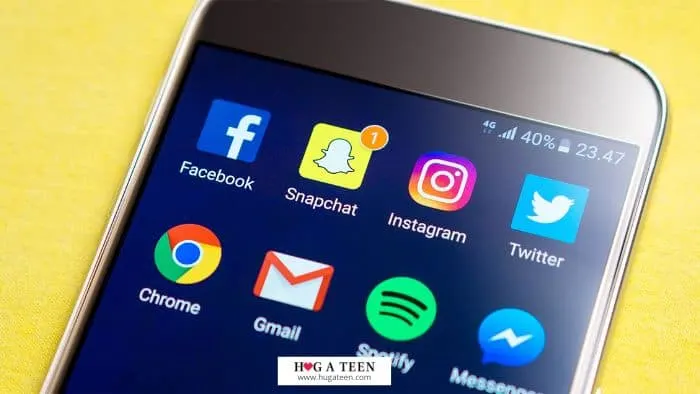Snapchat, a popular messaging app, has captured the attention of teens with millions of active users worldwide, particularly among the teen and tween demographic.
This article aims to provide a comprehensive overview of Snapchat, discussing its features, benefits, and potential drawbacks for young users.
Understanding The Pros and Cons of Snapchat for Teens
What is Snapchat?
Snapchat is a multimedia messaging app known for its unique feature of making messages, or ‘snaps,’ disappear after they are viewed. Unlike traditional social media apps, Snapchat offers a more casual and real-time communication experience.
Snapchat messaging app lets teens exchange user-generated photos, texts, videos, and calls. The platform is designed to promote creativity and spontaneity, with a range of filters and lenses that users can apply to their snaps. Snapchat’s ephemeral nature and focus on visuals set it apart from other platforms like Facebook or Instagram. You can learn more about Snapchat’s features from Snapchat’s Safety Center.
According to Snapchat, the average user is between 12 and 34 years old, and millions of users access the app about 20 times per day to stay in touch with friends.
❤️ Suggested reading: Snapchat Etiquette: Do’s & Dont’s

The Pros of Using Snapchat
The Snapchat app offers several benefits that contribute to its popularity among teens and tweens:
1. Creativity: Snapchat’s crazy filters and lenses allow users to transform their images in fun and creative ways. This feature encourages users to express themselves and their creativity.
2. Real-time communication: Snapchat is a fun way for kids to communicate with friends. They can share photos and videos and have a social life as well. Snapchat enables users to share moments as they happen. This real-time communication helps teens maintain friendships and stay connected with their peers.
3. Easy to use: Unlike other apps, Snapchat is easy to sign up for and use. It recommends a username specific to you, and you can register without having to put out your real name. The privacy settings on this app are quite difficult to bypass. Snapchat contains a user-friendly interface with amazing features that are easy to work with and maneuver around.
4. Free: Snapchat is free to use. There are no subscription fees or hidden costs.
5. Available on mobile and web: Snapchat is available on Android and iOS devices, as well as on most modern browsers, allowing you to enjoy all major functions on your phone or computer.
6. Snaps are temporary: Users can place viewing-related time restrictions on the Snaps they send — making them visible for one to 10 seconds, for instance, before disappearing from the recipient’s device. They can also opt to have friends view them for as long as they’d like, though, and senders will be able to see a record of it. The fleeting nature of snaps can make the platform feel more casual and less pressured compared to other social platforms where posts are permanent. There isn’t the same need to get ‘likes’ on your post as with other social media platforms. Because the content isn’t displayed permanently, people with malicious intentions can’t go and find it later.
📢 Suggested reading: Reasons Why Teens Stay Up Late
The Appeal of Snapchat to Teens & Tweens
Snapchat’s appeal to the younger demographic can be attributed to several factors:
1. Sense of community: Snapchat provides a platform for teens and tweens to connect with their peers and form a sense of community.
2. Fun and creative aspect: There are many fun filters and creative tools, along with the ability to share moments in real-time, making Snapchat an engaging platform for young users.
3. Privacy features: Snapchat’s disappearing messages and the ability to choose who can see their snaps give users a sense of control over their privacy. However, it’s important to note that while these features can provide a sense of security, they are not foolproof. For more information on privacy issues and safety on Snapchat, check out this [guide on Snapchat](https://cyberbullying.org/what-is-snapchat).
4. Limited marketing: Snapchat is not the ideal platform for marketing products, leading to commercial content being less interruptive
In the next part of this article, we will delve into the potential risks and downsides of Snapchat for teens and tweens, and discuss the role of parental guidance in ensuring safe use of the platform.
📢 Suggested reading: Controversial Topics For Teenagers
The Risks and Downsides of Snapchat for Teens & Tweens

The Cons of Using Snapchat
While Snapchat has its benefits, there are also some disadvantages of Snapchat and possible security concerns that parents and guardians should be aware of:
1. Screen time addiction: Like any social media site, Snapchat can be addictive. The constant need to check for updates and respond to snaps can lead to excessive screen time, which can interfere with other important activities like studying, physical activity, and face-to-face social interactions. Snapchat has all sorts of trophy emojis for showing friendship levels on Snapchat as well as snap streaks when you snap and chat with them a lot.
📢 Suggested reading: What Does The Yellow Heart Mean On Snapchat?
2. Privacy concerns: Despite Snapchat’s privacy features, there are still potential privacy risks. For example, the location-sharing feature can potentially expose a user’s current location to others. Additionally, while snaps are designed to disappear, recipients can still take screenshots or use other methods to save the content.
3. Difficulty finding friends: On other social media platforms such as Facebook and Twitter, you can find your friends by searching for their real names or phone numbers. If you want to use Snapchat, you’ll need your friend’s Snapchat ID, Snapcode, or their mobile number embedded on your phone. If you haven’t had contact with someone for a long time, this can make reconnecting quite challenging.
📢 Suggested reading: How To Ask A Girl For Her Snapchat
4. Mental health impact: The use of Snapchat and other social media platforms has been linked to various mental health issues in teens, such as anxiety, depression, and body image concerns. The filters on Snapchat give a false idea of beauty standards. This can affect your mental well-being, especially if you compare your actual self to the image you see after taking a selfie or a video on the app.
The app can be addictive and lead to FOMO, otherwise known as Fear of Missing Out. This is where teens feel they must constantly use the app to share stories to avoid missing out on anything important. This can make teens feel anxious or stressed about their social lives, leading to mental health problems.
The American Academy of Child & Adolescent Psychiatry provides more information on the impact of social media on teens.
5. Access to drugs: There is a potential risk of teenagers getting access to drugs through Snapchat and other social media platforms. Some drug dealers use these platforms to sell illegal substances, often using coded language or images to advertise their products.
Snapchat’s disappearing messages can make this kind of activity more difficult to detect and trace. Furthermore, the use of Snap Map, a feature that allows users to share their location, can potentially facilitate in-person transactions.
It’s important for parents to discuss these risks with their children and explain that they should only accept friend requests from people they know in real life. Parents should also report any suspicious activity to the platform and, if necessary, local law enforcement.
6. Disappearing snaps: One of the cons of Snapchat for parents is that the app does not keep snaps on for long, and its direct message feature does not make it any better. Therefore, parents cannot follow up on their child’s activities and the material they are putting on the world wide web. Because of the limited storage of outgoing (and incoming) pictures, videos, and texts, the app has also gained a reputation as a potential means of sexting.
7. Clickbait: As with many social platforms, there is quite a bit of clickbait, meaning that kids click on something that then shows something totally unrelated to what was mentioned.
Potential Privacy Risks
Snapchat has potential privacy risks for teens. Although there are several customizable privacy settings and security features, there are a few key points to consider if you have concerns about privacy.
1. Disappearing Content: Snapchat’s main feature is that photos and messages disappear after they’re viewed. However, this can give a false sense of security, and it’s important to remember that this doesn’t guarantee privacy. Recipients can take screenshots or use other screen recording methods to save the content. While Snapchat notifies users if a screenshot is taken, it can’t prevent the screenshot from being taken in the first place.
2. Snap Map: The Snap Map feature shows the location of the user when they open the app. Though this may allow parents to keep track of their kids where about, it allows anyone on their friend list to know their location and can potentially expose a user’s location to others. While users can choose who can see their location or turn on “Ghost Mode” to hide their location, young users might not be aware of these settings or understand the potential risks.
3. Privacy Settings: By default, only users who are friends on Snapchat can send snaps or quick messages to each other. However, the settings can be changed to allow anyone to send messages. If these settings are not properly managed, teens could potentially receive messages from strangers.
4. Data Privacy: Like any other social media platform, Snapchat collects data about its users. This includes information about the user’s activity on the app, device information, and location data. This information can be used for various purposes, such as targeted advertising.
For these reasons, it’s important for parents to discuss online privacy with their teens, ensure that privacy settings are appropriately configured, and possibly utilize parental control software to monitor their social media use.
Cyberbullying on Snapchat
Cyberbullying is a significant concern on all social media platforms, including Snapchat. The anonymity and ephemerality of Snapchat can sometimes make it an attractive platform for cyberbullies. Victims of cyberbullying can experience significant emotional distress and other negative impacts on the mental health of youth.
Parental Guidance and Control

Given the potential risks associated with Snapchat, parental guidance and control are crucial. Here are some tips for parents:
1. Open dialogue: Have regular conversations with your child about their use of Snapchat and other social media platforms. Discuss the potential risks and encourage them to share their experiences and concerns.
2. Set boundaries: Establish rules about when and how much your child can use Snapchat. For example, you might set a limit on screen time or designate certain times of the day as Snapchat-free.
3. Monitor use: Consider using parental control tools to monitor your child’s Snapchat use. Be open with your child about this monitoring to maintain trust.
4. Teach online safety: Educate your child about online safety, including the importance of not sharing personal information and not accepting friend requests from strangers.
📢 Suggested reading: Parental Awareness: Potentially Dangerous Apps For Teens
Related Snapchat Questions
What age is appropriate for Snapchat?
Kids of 13 years and below are viable to use Snapchat. However, that does not warrant that they use the platform because of the possibility of exposure to inappropriate content and systems that phish personal data. Therefore, Snapchat would be more appropriate for older teens, and Common Sense Media rates it for ages 16 and above.
Ultimately, parents or guardians make the decision whether to allow their teenagers to have Snapchat accounts based on their maturity level and ability to responsibly use the app.
Can I monitor my child’s Snapchat?
Snapchat has a Family Center feature that lets parents see the pages their teens are in contact with. However, it does not expose the texts, videos, or images communicated. The feature also allows parents to report accounts that are child inappropriate without the teen’s knowledge.
How addictive is Snapchat?
One negative influence of Snapchat on teens is that it may get addictive over time. The streak feature draws kids to Snapchat for hours because the higher your streak score gets, the higher the points are rewarded. It makes them want to be on Snapchat all day, streaking.
Conclusion
Snapchat offers a unique and engaging platform for teens and tweens to connect with their peers. Overall, there are several pros to using Snapchat, from the fun filters and snap streaks to the privacy settings that allow for safe sharing with friends.
However, like any social media platform, it comes with potential risks. By maintaining an open dialogue, setting boundaries, and providing guidance, parents can help ensure their child’s safety and well-being on Snapchat.
